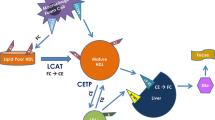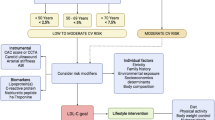Abstract
Background
Recent evidence on the use of statin therapy indicates the potential for ultra-low levels of LDL-C to provide greater protection from recurrent coronary heart disease events. Guidelines for the treatment of lipid disorders were revised to indicate that an LDL-C treatment goal of 70 mg/dl was optional (NCEP ATPIII). In these same guidelines, low levels of HDL-C are also suggested but not specifically proscribed as a target of therapy. Recently ARBITER 2 (Arterial Biology for the Investigation of the Treatment Effects of Reducing Cholesterol 2) has provided the first evidence of the potential of raising HDL-C with extended release niacin when added to statin monotherapy in secondary prevention. However, whether this approach would be superior to a strategy in which lower concentrations of LDL-C are targeted is unknown.
Materials and methods
ARBITER 6-HALTS ( HDL and LDL Treatment Strategies) will be a randomized, parallel group, open-label study comparing HDL-C and LDL-C focused strategies of lipid treatments for their effects on atherosclerosis. Up to 400 subjects will be assigned to either intensified LDL-C lowering therapy with ezetimibe or HDL-C raising therapy with extended-release niacin. The primary endpoint is the mean change in the intima-media thickness of the common carotid artery after 14 months. Secondary endpoints include the change in lipid values and lipid subfractions, drug discontinuation due to adverse effects, change in quality of life, and a composite endpoint consisting of all major adverse cardiovascular events.
Conclusion
ARBITER 6-HALTS will guide clinicians on whether a lipid treatment strategy of raising HDL-C or further LDL-C reduction is superior in the secondary prevention of coronary heart disease.

Similar content being viewed by others
References
de Groot E, Jukema JW, van Boven AJ, Reiber JH, Zwinderman AH, Lie KI, et al. Effect of pravastatin on progression and regression of coronary atherosclerosis and vessel wall changes in carotid and femoral arteries: a report from the Regression Growth Evaluation Statin Study. Am J Cardiol 1995;76:40C–6C.
Cashin-Hemphill L, Mack WJ, Pogoda JM, Sanmarco ME, Azen SP, Blankenhorn DH. Beneficial effects of colestipol-niacin on coronary atherosclerosis. A 4-year follow-up [see comments]. JAMA 1990;264:3013–7.
Azen SP, Mack WJ, Cashin-Hemphill L, LaBree L, Shircore AM, Selzer RH, et al. Progression of coronary artery disease predicts clinical coronary events. Long-term follow-up from the Cholesterol Lowering Atherosclerosis Study. Circulation 1996;93:34–41.
Mack WJ, Selzer RH, Hodis HN, Erickson JK, Liu CR, Liu CH, et al. One-year reduction and longitudinal analysis of carotid intima-media thickness associated with colestipol/niacin therapy. Stroke 1993;24:1779–83.
Brown G, Albers JJ, Fisher LD, Schaefer SM, Lin JT, Kaplan C, et al. Regression of coronary artery disease as a result of intensive lipid-lowering therapy in men with high levels of apolipoprotein B [see comments]. N Engl J Med 1990;323:1289–98.
Brown BG, Zhao XQ, Chait A, Fisher LD, Cheung MC, Morse JS, et al. Simvastatin and niacin, antioxidant vitamins, or the combination for the prevention of coronary disease. N Engl J Med 2001;345:1583–92.
Taylor AJ, Sullenberger LE, Lee HJ, Lee JK, Grace KA. Arterial Biology for the Investigation of the Treatment Effects of Reducing Cholesterol (ARBITER) 2: a double-blind, placebo-controlled study of extended-release niacin on atherosclerosis progression in secondary prevention patients treated with statins. Circulation 2004;110:3512–7.
Taylor AJ, Lee HJ, Sullenberger LE. The effect of 24 months of combination statin and extended-release niacin on carotid intima-media thickness: ARBITER 3. Curr Med Res Opin 2006;22:2243–50.
Nissen SE, Tuzcu EM, Schoenhagen P, Brown BG, Ganz, Vogel RA, et al. Effect of intensive compared with moderate lipid-lowering therapy on progression of coronary atherosclerosis: a randomized controlled trial. JAMA 2004;291:1071–80.
Taylor AJ, Kent SM, Flaherty PJ, Coyle LC, Markwood TT, Vernalis MN. ARBITER: Arterial Biology for the Investigation of the Treatment Effects of Reducing Cholesterol: a randomized trial comparing the effects of atorvastatin and pravastatin on carotid intima medial thickness. Circulation 2002;106:2055–60.
Bays HE, Ose L, Fraser N, Tribble DL, Quinto K, Reyes R, et al. A multicenter, randomized, double-blind, placebo-controlled, factorial design study to evaluate the lipid-altering efficacy and safety profile of the ezetimibe/simvastatin tablet compared with ezetimibe and simvastatin monotherapy in patients with primary hypercholesterolemia. Clin Ther 2004;26:1758–73.
Davidson MH, McGarry T, Bettis R, Melani L, Lipka LJ, LeBeaut AP, et al. Ezetimibe coadministered with simvastatin in patients with primary hypercholesterolemia. J Am Coll Cardiol 2002;40:2125–34.
Wong M, Edelstein J, Wollman J, Bond MG. Ultrasonic-pathological comparison of the human arterial wall. Verification of intima-media thickness. Arterioscler Thromb 1993;13:482–6.
Azen SP, Mack WJ, Cashin-Hemphill L, LaBree L, Shircore Am, Selzer RH, et al. Progression of coronary artery disease predicts clinical coronary events. Long-term follow-up from the Cholesterol Lowering Atherosclerosis Study. Circulation 1996;93:34–41.
Buchwald H, Matts JP, Fitch LL, Campos CT, Sanmarco ME, Amplatz K, et al. Changes in sequential coronary arteriograms and subsequent coronary events. Surgical Control of the Hyperlipidemias (POSCH) group. JAMA 1992;268:1429–33.
Burke GL, Evans GW, Riley WA, Sharrett AR, Howard G, Barnes RW, et al. Arterial wall thickness is associated with prevalent cardiovascular disease in middle-aged adults. The Atherosclerosis Risk in Communities (ARIC) Study. Stroke 1995;26:386–91.
Jukema JW, Bruschke AV, van Boven AJ, Reiber JH, Bal ET, Zwinderman AH. Effects of lipid lowering by pravastatin on progression and regression of coronary artery disease in symptomatic men with normal to moderately elevated serum cholesterol levels. The Regression Growth Evaluation Statin Study (REGRESS). Circulation 1995;91:2528–40.
O’Leary DH, Polak JP, Wolfson SK, Bond MG, Bommer W, Sheth S, et al. Use of sonography to evaluate carotid atherosclerosis in the elderly: the Cardiovascular Health Study. Stroke 1991;22:1155–63.
Howard G, Sharrett AR, Heiss G, Evans GW, Chambless LE, Riley WA, et al. Carotid artery intimal-medial thickness distribution in general population as evaluated by B-mode ultrasound. Stroke 1993;24:1297–304.
Crouse JE, Craven TE, Hagaman AP, Bond MG. Association of coronary disease with segment-specific intimal-medial thickening of the extracranial carotid artery. Circulation 1995;92:1141–47.
Stensland-Bugge E, Bonaa KH, Joakimsen O. Reproducibility of ultrasonographically determined intima-media thickness is dependent on arterial wall thickness. The Tromso Study. Stroke 1997;28:1972–80.
del Sol AI, Moons KGM, Hollander M. Is carotid intima-media thickness useful in cardiovascular disease risk assessment? The Rotterdam Study. Stroke 2001;32:1532–8.
Schweikert B, Hahmann H, Leidl R. Validation of the EuroQol questionnaire in cardiac rehabilitation. Heart 2006;92:62–7.
Fleming TR, Harrington DP, O’Brien PC. Designs for group sequential tests. Control Clin Trials 1984;5:348–61.
Author information
Authors and Affiliations
Corresponding author
Additional information
The opinions or assertions herein are the private views of the authors and are not to be construed as reflecting the views of the Department of the Army or the Department of Defense.
Rights and permissions
About this article
Cite this article
Devine, P.J., Turco, M.A. & Taylor, A.J. Design and Rationale of the ARBITER 6 Trial (Arterial Biology for the Investigation of the Treatment Effects of Reducing Cholesterol)-6-HDL and LDL Treatment Strategies in Atherosclerosis (HALTS). Cardiovasc Drugs Ther 21, 221–225 (2007). https://doi.org/10.1007/s10557-007-6020-8
Published:
Issue Date:
DOI: https://doi.org/10.1007/s10557-007-6020-8




